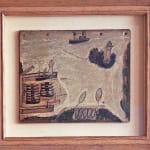Alfred Wallis 1855-1942
St Ives Harbour and Godrevy Lighthouse, c1930s
oil on board
12 x 14 1/2 inches
30.5 x 36.8 cm
30.5 x 36.8 cm
‘The bird’s-eye view of St Ives harbour and bay was one of Alfred Wallis’s most favourite subjects, and he painted it a number of times. A similar version was bought...
‘The bird’s-eye view of St Ives harbour and bay was one of Alfred Wallis’s most favourite subjects, and he painted it a number of times. A similar version was bought directly from the artist by Barbara Hepworth, who told me how the artist wrote on the back of it for her benefit “This is Sain fishery That use To be”. Like a great many of his paintings it was intended as a tribute to the local fishing industry as Wallis had experienced it in his younger days before it’s sad decline - “what use to Bee….out of my own memery”, as he described his work. The seine nets, shown here off Porthminster Beach, were for trapping pilchards. Whenever a shoal was spotted every able-bodied man in St Ives would rush down to the shore to haul in the nets: the pilchards were then packed and exported to Italy.
Typically, Wallis has concertina’d a broad area of sea and coastline into a compact composition in order to emphasise its salient features - St.Ives harour with mackerel boats beached at low tide, Porthminster Beach with its seine nets, Hayle Estuary, the long stretch of coastline beyond, and Godrevy Lighthouse across the bay. Ben Nicholson, who with Christopher Wood ‘discovered’ Wallis in 1928, used to emphasise to me in his letters that Wallis invariably described his paintings as “actual events”: they were a way of re-living his past, telling his own story.
One of the most appealing characteristics of all Wallis’s work is the way he would make use of whatever scraps of board that happened to be available: these were often cartons and old packing-cases given to him by the local grocer. But instead of disguising their origin Wallis would incorporate their irregularities into the design of his pictures, making a virtue of whatever shape, texture and colour they chanced to have. His own colours were similarly restricted by what he could manage to lay his hands on - invariably ship’s paint (“real paint” as he proudly described it), never artists’ colours, which he thoroughly despised. As he wrote with great self-assurance to one of his few faithful collectors, H.S.Ede, in 1935, ‘I do not put Collers what do not Belong. I Think it spoils The pictures’.
Edwin Mullins, London, December 2002
Typically, Wallis has concertina’d a broad area of sea and coastline into a compact composition in order to emphasise its salient features - St.Ives harour with mackerel boats beached at low tide, Porthminster Beach with its seine nets, Hayle Estuary, the long stretch of coastline beyond, and Godrevy Lighthouse across the bay. Ben Nicholson, who with Christopher Wood ‘discovered’ Wallis in 1928, used to emphasise to me in his letters that Wallis invariably described his paintings as “actual events”: they were a way of re-living his past, telling his own story.
One of the most appealing characteristics of all Wallis’s work is the way he would make use of whatever scraps of board that happened to be available: these were often cartons and old packing-cases given to him by the local grocer. But instead of disguising their origin Wallis would incorporate their irregularities into the design of his pictures, making a virtue of whatever shape, texture and colour they chanced to have. His own colours were similarly restricted by what he could manage to lay his hands on - invariably ship’s paint (“real paint” as he proudly described it), never artists’ colours, which he thoroughly despised. As he wrote with great self-assurance to one of his few faithful collectors, H.S.Ede, in 1935, ‘I do not put Collers what do not Belong. I Think it spoils The pictures’.
Edwin Mullins, London, December 2002
3
of
3



